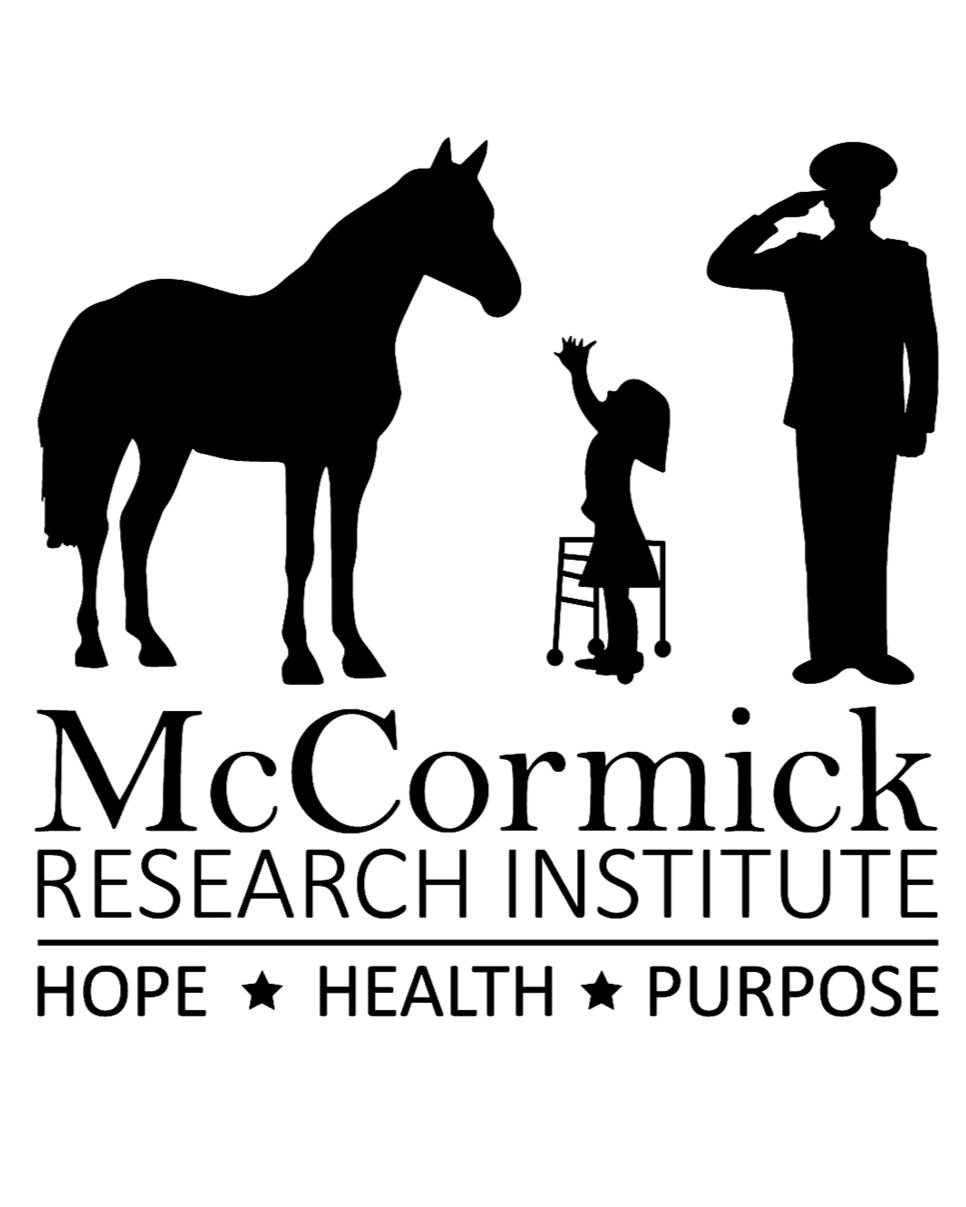Efficacy of Therapeutic Horseback Riding in Children with Autism Spectrum Disorder Literature Review
McCormick Research Institute, Dr. Ashleigh Darnell
Literature regarding military veterans and mental health or wellbeing help-seeking:
Cohen, B., Gima, K., Bertenthal, D., Kim, S., Marmar, C., & Seal, K. (2010). Mental health diagnoses and utilization of VA non-mental health medical services among returning Iraq and Afghanistan veterans. Journal of General Internal Medicine, 25(1), 18–24. doi:10.1007/s11606-009-1117-3
Fontana, A., & Rosenheck, R. (2008). Treatment-seeking veterans of Iraq and Afghanistan: Comparison with veterans of previous wars. Journal of Nervous and Mental Disease, 196, 513–521. doi:10.1097/NMD.0b013e31817cf6e6
Hoge, C., Castro, C., Messer, S., McGurk, D., Cotting, D., & Koffman, R. L. (2004). Combat duty in Iraq and Afghanistan, mental health problems, and barriers to care. New England Journal of Medicine, 351(1), 13–22.
Kehle, S., Polusny, M., Murdoch, M., Erbes, C., Arbisi, P., & Thuras, P. (2010). Early mental health treatment-seeking among U.S. National Guard soldiers deployed to Iraq. Journal of Traumatic Stress, 23, 33–40.
Kim, P., Thomas, J., Wilk, J., Castro, C., & Hoge, C. (2010). Stigma, barriers to care, and use of mental health services among active duty and National Guard soldiers after combat. Psychiatric Services, 61(6), 572–588. doi:10.1176/appi.ps.61.6.582
Manger, T, & Motta, R. (2005). The impact of an exercise program on posttraumatic stress disorder, anxiety, and depression. Int J Emerg Ment Health, 7(1), 49-57.
Click Here
Seal, K., Maguen, S., Cohen, B., Gima, K. S., Metzler, T. J., Ren, L., … Marmar, C. R. (2010). VA mental health services utilization in Iraq and Afghanistan veterans in the first year of receiving new mental health diagnoses. Journal of Traumatic Stress, 23(1), 5–16. doi:10.1002/Jts.20493
Click Here
Literature regarding measurement of animal-assisted interventions:
Thompson, J. R., Iacobucci, V., & Varney, R. (2012). Giddyup! or Whoa Nelly! Making Sense of Benefit Claims on Websites of Equine Programs for Children with Disabilities. Journal of Developmental and Physical Disabilities, 24(4), 373–390. doi:10.1007/s10882-012-9276-2
Click Here
Wilson, C. C., & Netting, F. E. (2012). The Status of Instrument Development in the Human–Animal Interaction Field. Anthrozoos: A Multidisciplinary Journal of The Interactions of People & Animals (Vol. 25). doi:10.2752/175303712X13353430376977
Click Here
Literature regarding efficacy or effectiveness of equine-assisted interventions:
Anestis, M. D., Anestis, J. C., Zawilinski, L. L., Hopkins, T. a., & Lilienfeld, S. O. (2014). Equine-Related Treatments For Mental Disorders Lack Empirical Support: A Systematic Review of Empirical Investigations. Journal of Clinical Psychology, 70(12), 1115–1132. doi:10.1002/jclp.22113
Bachi, K. (2012). Equine-facilitated psychotherapy: The gap between practice and knowledge. Society & Animals, 20(4), 364–380. doi:10.1163/15685306-12341242
Bates, A. (2002). Of patients & horses: Equine-facilitated psychotherapy. Journal of Psychosocial Nursing & Mental Health Services, 40(5).
Click Here
Bertoti, D. B. (1988). Effects of therapeutic horseback riding on posture in children with cerebral palsy. Journal of the American Physical Therapy Association, 68(10), 1505-1512.
Click Here
García-gómez, A., Risco, M. L., Car-, J., Rubio, L., Guerrero, E., & García-, I. M. (2014). Effects of a Program of Adapted Therapeutic Horse-riding in a Group of Autism Spectrum Disorder Children. Electronic Journal of Research in Educational Psychology, 12(1), 107–128. doi:10.14204/ejrep.32.13115
Click Here
Heimlich, K. (2001). Animal-assisted therapy and the severely disabled child: A quantitative study. Journal of Rehabilitation, 67 (4), October/November/December, 48-54.
Click Here
Kendall, E., Maujean, A., Pepping, C., Downes, M., Lakhani, A., Byrne, J., & Macfarlane, K. (2015). A systematic review of the efficacy of equine-assisted interventions on psychological outcomes. European Journal of Psychotherapy & Counselling, (May), 1–23. doi:10.1080/13642537.2014.996169
Click Here
Klontz, B., Bivens, A., Leinart, D., & Klontz, T. (2007). The effectiveness of equine-assisted experiential therapy: Results of an open clinical trial. Society & Animals, 15(3), 257–267. doi:10.1163/156853007X217195
Click Here
Lanning, B., Baier, M., Ivey-Hatz, J., Krenek, N., & Tubbs, J. (2014). Effects of Equine Assisted Activities on Autism Spectrum Disorder. Journal of Autism and Developmental Disorders, 1–11. doi:10.1007/s10803-014-2062-5
Click Here
Maujean, A., Kendall, E., Roquer, L., Sharp, T., & Pringle, G. (2013). Connecting for health: Playing with horses as a therapeutic tool. Journal of Community Psychology, 41(4), 515–522. doi:10.1002/jcop.21547
Click Here
Muñoz-Lasa, S, Ferriero, G, Valero, R, Gomez-Muñiz, F, Rabini, A, Varela, E. (2011) Effect of therapeutic horseback riding on balance and gait of people with multiple sclerosis. G Ital Med Lav Ergon, 33(4), 462-7.
Pendry, P., Carr, A. M., Smith, A. N., & Roeter, S. M. (2014). Improving Adolescent Social Competence and Behavior: A Randomized Trial of an 11-Week Equine Facilitated Learning Prevention Program. The Journal of Primary Prevention, 35(4), 281–293. doi:10.1007/s10935-014-0350-7
Click Here
Roberts, F., Bradberry, J., & Williams, C. (2004). Equine-Facilitated Psychotherapy Benefits Students and Children. Holistic Nursing Practice, 18(1).
Click Here
Selby, A., & Smith-Osborne, A. (2013). A systematic review of effectiveness of complementary and adjunct therapies and interventions involving equines. Health Psychology, 32(4), 418–32. doi:10.1037/a0029188
Click Here
Sockalingam, S, Li, M, Krishnadev, U, Hanson, K, Balaban, K, Pacione, L, Bhalerao, S. (2008) Use of animal-assisted therapy in the rehabilitation of an assault victim with a concurrent mood disorder. Issues in Mental Health Nursing, 29(1), 73-84.
Click Here
Sterba J.A. (2007) Does horseback riding therapy or therapist-directed hippotherapy rehabilitate children with cerebral palsy? Developmental Medicine and Child Neurology, 49(1), 68-73.
Click Here
Vidrine, M., Owen-Smith, P., & Faulkner, P. (2002). Equine Facilitated group psychotherapy: Applications for therapeutic vaulting. Issues in Mental Health Nursing, 23, 587–603.
Click Here
Wharton, T., Sercu, C., Malone, M., & Macauley, B. (2005). An Analysis of Equine Stress Levels after Participation in Therapy Sessions. Scientific and Educational Journal of Therapeutic Riding, December.
Click Here
Zadnikar, M Kkastrin, A. (2011), Effects of hippotherapy and therapeutic horseback riding on postural control or balance in children with cerebral palsy: a meta-analysis. Developmental Medicine & Child Neurology, 53, 684–691.
Click Here
Literature regarding human-animal bond and other types of animal-assisted therapy:
Allen, K., Shykoff, B., & Izzo, J. (2001). Pet ownership, but not ACE inhibitor therapy blunts home blood pressure response to mental stress. Hypertension, 38, 815-820.
Click Here
Altschuler, E. (1999). Pet-facilitated therapy for posttraumatic stress disorder. Annals of Clinical Psychiatry, 11(1), 29-30.
Click Here
Barker, S.B., Rogers, C.S., Turner, J.W., Karpf, A.S, & Suthers-McKabe, H.M. (Sept 2003). Benefits of interacting with Companion animals: A bibliography of articles published in refereed journals during the past 5 years. The American Behavioral Scientist, 47(1), 94.
Click Here
Barker, S.B. (1999). Therapeutic aspects of the human-companion animal interaction. Psychiatric Times, February, 45-46.
Click Here
Brickel, C. A. (1986). Pet-facilitated therapies: A review of the literature and clinical implementation considerations. Clinical Gerontologist, 5(3-4), 309-332.
Click Here
Casey, H.M. (1996). A survey of occupational therapists using pet-facilitated therapy. Home Health Care Management & Practice, 8, 10-17.
Click Here
Netting. F. E., Wilson, C. C., New, J. C. (1987). The human-animal bond: Implications for practice. Social Work, 32(1), 60-64.
Click Here
Raina, P., Waltner-Toews, D., Bonnett , B. Woodward, C. & Abernathy, T. (1999). Influence of companion animals on the physical and psychological health of older people: An analysis of a one-year longitudinal study. JAGS: Journal of Am Geriatr Soc, 47(3):323-9.
Click Here
Literature related to theoretical supports:
Bachi, K. (2013). Application of attachment theory to equine-facilitated psychotherapy. Journal of Contemporary Psychotherapy, 43(3), 187–196. doi:10.1007/s10879-013-9232-1
Click Here
Barsalou, L. (1999). Perceptual symbol systems. Behavioral Brain Science, 22, 577-660.
Click Here
Casasanto, D. (2009). Embodiment of Abstract Concepts: Good and Bad in Right- and Left-Handers. Journal of Exploratory Psychology, 138, 351-367.
Click Here
Casasanto, D. & Dijkstra, K. (2010). Motor action and emotional memory. Cognition, 115, 179-185.
Click Here
Dijkstra, K., et al. (2007). Body posture facilitates retrieval of autobiographical memories. Cognition, 102, 139-149.
Click Here
Garner, B., & Rigby, B. (2015). Human pelvis motions when walking and when riding a therapeutic horse. Human Movement Science, 39, 121–137. doi:10.1016/j.humov.2014.06.011
Click Here
Kahn, P. (1997). Developmental Psychology and the Biophilia Hypothesis: Children’s Affiliation with Nature, Developmental Review, 17(1), 1–61. doi:10.1006/drev.1996.0430
Click Here
Links to reports, non-peer reviewed articles, reviews, editorials, or websites that may be of interest:
Burgess L. Wounded veterans get back in the saddle - Pilot program uses horseback riding as physical therapy. Stars and Stripes (2006).
CADTH. (2012). Therapy dogs and horses for mental health: A review of the clinical effectiveness. Canadian Association for Drugs and Technology in Health.
Click Here
Zane T. A Horse of a Different Color: A Review of the Effectiveness of Hippotherapy.
Department Of Veterans Affairs. (2014). U.S. Department of Veterans Affairs: Mental Health: PTSD.
Returning Home from Iraq and Afghanistan: Assessment of Readjustment Needs of Veterans, Service Members, and Their Families. (2013). The National Academies Press. Retrieved from
Tanielian, T., & Jaycox, L. (2008). Invisible wounds of war: Psychological and cognitive injuries, their consequences, and services to assist recovery. RAND: Santa Monica, CA.
Click Here


